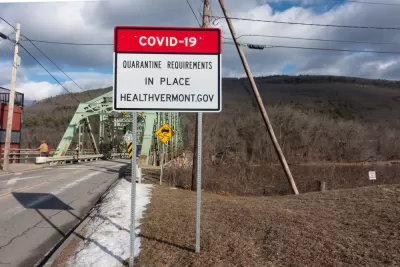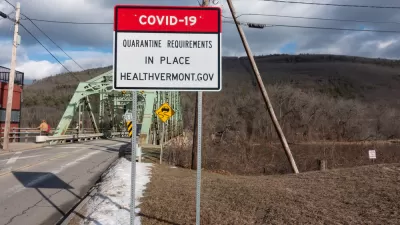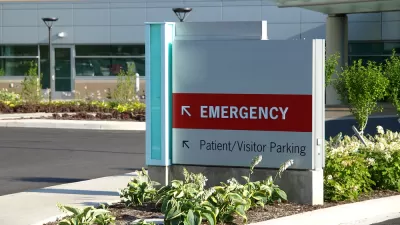PBS NewsHour investigates the surging coronavirus cases and hospitalizations in Vermont which, along with Rhode Island, has 75% of its total population fully vaccinated, the nation's highest, as the U.S. appears to enter a winter surge.

"Experts say that COVID-19 cases will continue to rise in the weeks ahead this winter, and that we will see more omicron cases here in the United States in the days, weeks and months ahead," wrote President Biden in an opinion published in USA Today on December 1.
For that reason, Planetizen revisits one of the nation's two most vaccinated states to get an update on what to expect when three-quarters of a state's population is fully vaccinated against a novel disease that is responsible for at least 800,000 deaths in the U.S. since the first recorded death on Feb. 29, 2020.
William Brangham, a correspondent and producer for PBS NewsHour, sat down with Dr. Rick Hildebrant, the chief medical information officer and medical director of hospital medicine at Rutland Regional Medical Center in Vermont, to find out what has gone wrong in the state widely hailed as a coronavirus success earlier in the pandemic.
Notwithstanding its current health woes, Vermont continues to have the lowest cumulative COVID death rate among states: 67 people per 100,000 people, according to Statista as of December 8, 2021. Mississippi, with 346 deaths per 100k, has the highest. However, the average death rate from COVID during the last week puts Vermont at #23, i.e., 22 states, all with lower levels of vaccination save Rhode Island, had lower per capita death rates, according to The New York Times coronavirus tracker on Dec. 11.
"Vermont, with its widespread and early adoption of vaccines and other mitigation measures, was held up as a model for how to handle the pandemic," states Brangham in the introduction of the six-minute interview which aired on Dec. 9 and appears in the source article along with the transcript.
But the last month, the state blew past its record case and hospitalization numbers. The surge that hit much of the South earlier this year has arrived in New England.
[Planetizen's first pandemic visit to the Green Mountain State was in late September. Cases were dropping nationwide after peaking on Sept. 1 at nearly 165,000 as the Delta surge receded in the South. Vermont was also seeing a drop in cases having reached an all-time pandemic high of 219 average new daily cases on Sept. 21.]
"Help us understand what you're seeing in your hospital right now," asks Brangham.
Dr. Rick Hildebrant: We're seeing a lot of cases of COVID. We did not see the number of cases, as you mentioned, earlier in the year, and now we are seeing a very large spike. It's in all avenues of care. We're seeing it in the emergency department. We're seeing it in the intensive care unit, and we're seeing it on the inpatient units.
[The 7-day average of new daily cases on Dec. 10 was 455, according to the Times Vermont tracker. The 7-day average of COVID hospitalizations was 86, shattering the prior high during the winter 2021 surge of 65 on Feb. 5 when far fewer people were fully vaccinated. All adults became eligible for vaccination on April 19 in Vermont.]
William Brangham: So, help us understand, because Vermont has — I believe it's the highest vaccination rate, 75-or-something percent, in the country, We were sort of always led to believe that, if we get to three-quarters of a population, that we wouldn't see what you're seeing. How is that happening?
New England and national COVID metrics
Rhode Island and Vermont have the nation's highest level of their population fully vaccinated: 75%, according to The New York Times tracker on Dec. 11. The national average is 61%.
The two New England states also have the nation's third and fourth highest coronavirus case incidence: 87 cases per 100,000 people, +94% in the last two weeks, and 78 cases per 100,000 people, + 29% in the last two weeks, respectively, according to the Times. Only the Northern Mariana Islands and New Hampshire are higher. National case incidence is 36 per 100k, +38% in the last two weeks.
What went wrong
Hildebrandt's explanation:
"First of all, when those assumptions were made, that was based on the native virus, not on the Delta variant of the virus. The Delta variant is just far more contagious. And that 75 percent number is not nearly enough to have herd immunity for a community. It's way higher than that, 90-plus percent."
In fact, the entire notion of herd immunity is questionable for COVID. Waning immunity, as Hildebrant goes on to discuss, is far more relevant.
"We did have a very robust adoption of the vaccine. But that was almost a year ago. A year ago, people are rushing to get vaccinated. That immunity has waned. And after 10 months, the immunity is waned to the point at which people can contract COVID."
Vaccinated people as vectors
"Now, the people who are getting COVID who have been vaccinated are generally not that sick. They're having mild illness. But they're acting as vectors. They're spreading the illness to other individuals who are unvaccinated and are getting very sick and are landing in the emergency department."
Update: Breakthrough infections, hospitalizations
In Planetizen's earlier visit to the Green Mountain State, "Boosters and Breakthroughs in Vermont," Elizabeth Murray, public safety reporter at the Burlington Free Press, reported that Gov. Phil Scott said during his weekly news conference on Sept. 21 "that unvaccinated people are accounting for about 80% of hospitalizations and 83% of people admitted to the intensive care unit for COVID-19." I.e., breakthrough infections accounted for a minority but still significant number of COVID patients needing to be hospitalized.
Breakthrough hospitalizations have increased to nearly 30% of COVID hospital admissions and 19% of ICU admissions according to Vermont Department of Health data published by the Associated Press (via the Burlington Free Press) on Dec. 1.
Boosters
Brangham asks how the booster campaign has been going.
"Unfortunately, not nearly as well as the initial vaccination efforts went.
"The booster uptake in Vermont has not been very good. And that has contributed significantly to the spike that we're seeing right now."
Holiday gatherings
"We definitely saw a big peak a few weeks after the Halloween holiday. And we're seeing another peak now on the coattails of that related likely to Thanksgiving and small indoor group gatherings. We have seen nothing, however, other than increased number of cases for the last several weeks."
The state's epidemic curve corresponds exactly with what Hildebrant stated. Cases had peaked on Oct. 17 and dropped to a nadir on Halloween and then shot straight up. A somewhat similar pattern appears for the days before and after Thanksgiving.
"And, unfortunately, there doesn't seem to be an end in sight," adds Hildebrant.
Ending on a positive note
While that outlook may appear gloomy, that's not how the interview ended.
Brangham: Given the trends that you're describing, I know it's cold and getting colder. The holidays are coming. Omicron, with its unknowns, are coming.
How concerned are you about what's down the road?
Hildebrant: If we did not have a robust surge plan in place, I'd be very concerned.
It's all about having the appropriate plans in place. So we have been working for a very long time. We know in the South that hospital systems were overwhelmed. And we never wanted to find ourselves in that type of scenario. So we developed a very robust surge plan that includes the ability to care for a large number of patients.
Not by vaccines alone
This post began by citing President Biden on what lies ahead as COVID infections increase in the weeks ahead. Biden urges unvaccinated Americans to get vaccinated, and vaccinated Americans to get boosted. The post ends with a reminder from the director-general of the World Health Organization, Dr Tedros Adhanom Ghebreyesus, about the limitations of vaccines.
"A vaccine will complement the other tools we have, not replace them," director-general Tedros Adhanom Ghebreyesus said on Nov. 15. "A vaccine on its own will not end the pandemic."
"We continue to recommend the tailored and proportionate use of testing, masks, physical distancing, measures to prevent crowding, improve ventilation, and more," Tedros said three days earlier. "And get vaccinated when it’s your turn. "
Related in Planetizen:
- Boosters and Breakthroughs in Vermont, October 4, 2021
- CDC: Time to Rethink Herd Immunity, Nov 21, 2021
- Pandemic Paradox: World's Most Vaccinated Country Also the Most Infected, May 14, 2021
- Pandemic Geography: What's Wrong in Rhode Island? December 13, 2020
FULL STORY: Despite strong vaccination rate, Vermont sees COVID spike amid booster shot lag

Study: Maui’s Plan to Convert Vacation Rentals to Long-Term Housing Could Cause Nearly $1 Billion Economic Loss
The plan would reduce visitor accommodation by 25,% resulting in 1,900 jobs lost.

North Texas Transit Leaders Tout Benefits of TOD for Growing Region
At a summit focused on transit-oriented development, policymakers discussed how North Texas’ expanded light rail system can serve as a tool for economic growth.

Why Should We Subsidize Public Transportation?
Many public transit agencies face financial stress due to rising costs, declining fare revenue, and declining subsidies. Transit advocates must provide a strong business case for increasing public transit funding.

Alabama: Trump Terminates Settlements for Black Communities Harmed By Raw Sewage
Trump deemed the landmark civil rights agreement “illegal DEI and environmental justice policy.”

Dear Tesla Driver: “It’s not You, It’s Him.”
Amidst a booming bumper sticker industry, one writer offers solace to those asking, “Does this car make me look fascist?”

A Visual Celebration of Manhattan’s Chinatown Elder Community, Through Food
Lanterns, cafeteria trays, and community connection take center stage in this stunning photo essay.
Urban Design for Planners 1: Software Tools
This six-course series explores essential urban design concepts using open source software and equips planners with the tools they need to participate fully in the urban design process.
Planning for Universal Design
Learn the tools for implementing Universal Design in planning regulations.
City of Santa Clarita
Ascent Environmental
Institute for Housing and Urban Development Studies (IHS)
City of Grandview
Harvard GSD Executive Education
Toledo-Lucas County Plan Commissions
Salt Lake City
NYU Wagner Graduate School of Public Service





























